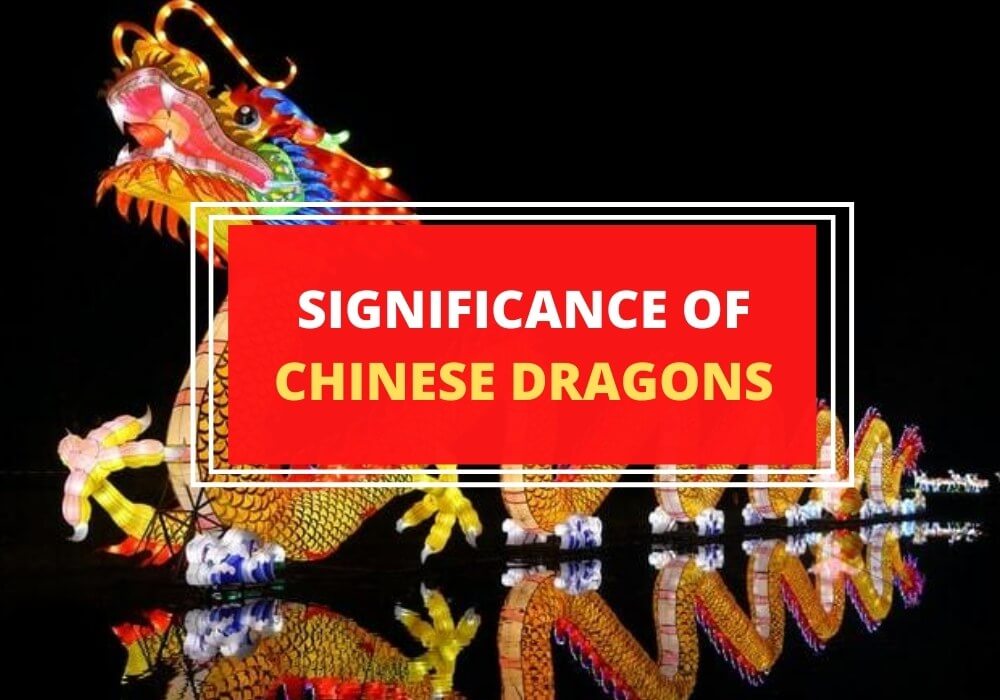
Table of Contents
Dragons are among the most popular symbols in China and are widely regarded as the most recognizable Chinese symbol outside of the country as well. The dragon myth has been a part of the culture, mythology, and philosophy of all Chinese kingdoms and is deeply treasured to this day.
Types of Chinese Dragons
There are many variations of Chinese dragons, with ancient Chinese cosmogonists defining four main types:
- Celestial Dragon (Tianlong): These protect the heavenly abodes of the gods
- Earth Dragon (Dilong): These are the well-known water spirits, that control the waterways
- Spiritual Dragon (Shenlong): These beings have power and control over the rain and winds
- Dragon of Hidden Treasure (Fuzanglong): These dragons guarded hidden buried treasure, both naturally occurring and man-made
Appearance of Chinese Dragons
Called Lóng or Lung in Mandarin, Chinese dragons have a very unique look compared to their European counterparts. Instead of having shorter and bulkier bodies with giant wings, Chinese dragons have a more slender snake-like physique with smaller bat-like wings. Lung dragons were often represented with four feet, two feet or no feet at.
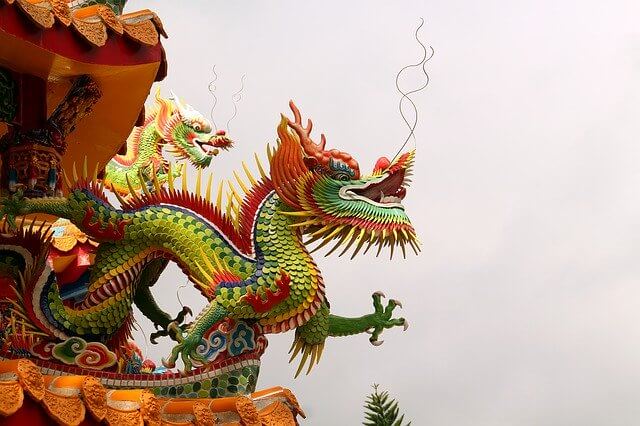
Their heads are somewhat similar to those of European dragons in that they have large maws with long teeth and wide nostrils, as well as two horns, often protruding from their foreheads. Another noteworthy difference is that Chinese dragons tend to have whiskers too.
Unlike their western brethren, Chinese dragons are traditionally masters of water and not fire. In fact, Chinese Lung dragons are viewed as powerful water spirits that command the rains, typhoons, rivers, and seas. And, similar to water spirits and deities in most other cultures, Chinese dragons were viewed as benevolent protectors of the people.
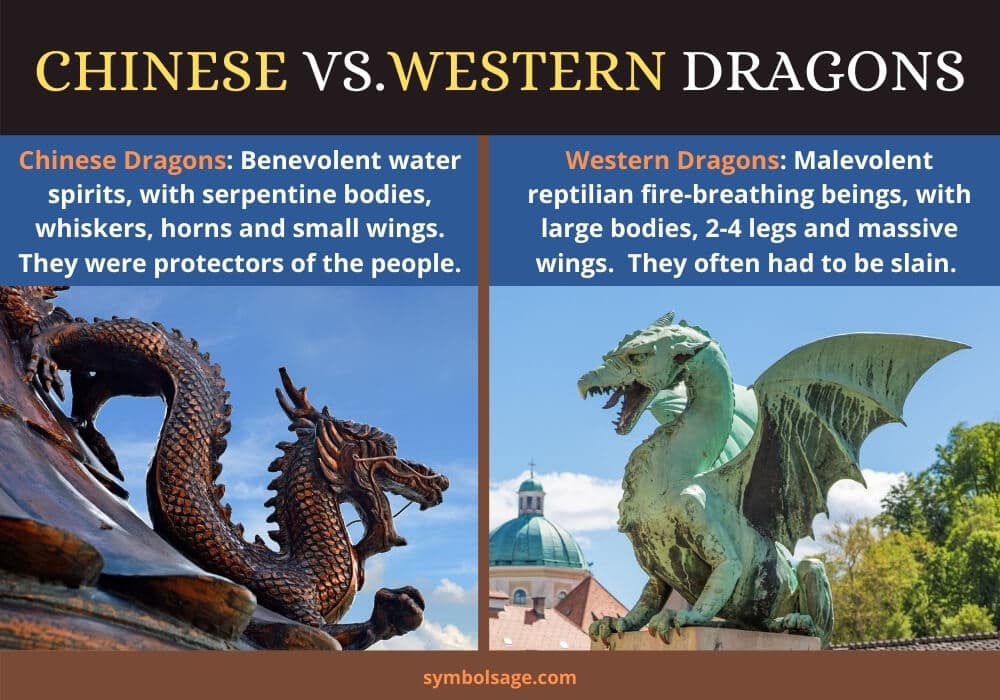
In recent decades and centuries, Chinese dragons are also represented as breathing fire but that’s almost certainly influenced by western dragons as the traditional Chinese Lung dragons were strictly water spirits. This may not be the only western influence, however, as some historians such as John Boardman believe the visual appearance of the Chinese dragon may have also been influenced by the Greek kētŏs, or Cetus, amythological creature which was a giant fish-like sea monster as well.
The signature snake-like physique is not just a stylish choice, but is meant to represent the evolution of the Chinese civilization as a whole – from a humble and plain snake to a mighty and powerful dragon.
Chinese Dragon Symbolism
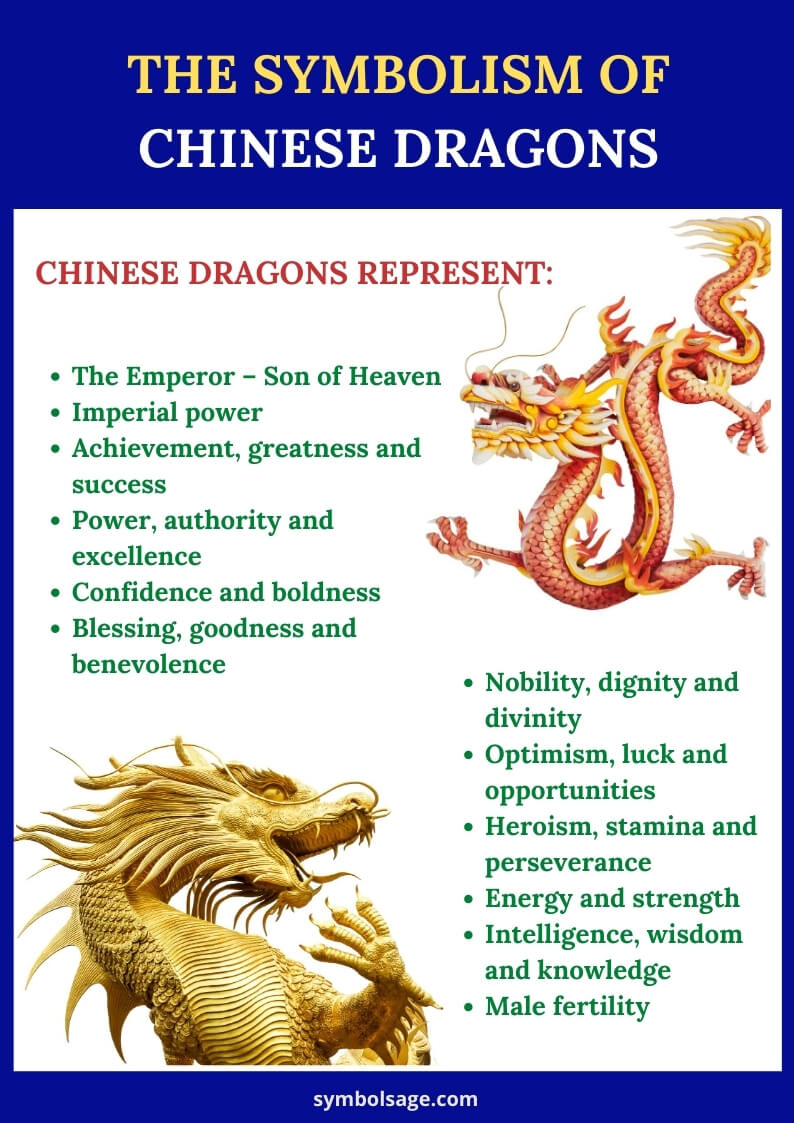
Traditionally, Chinese dragons symbolize strong and auspicious powers, control over water, typhoons, rain and floods. As they were considered to be water spirits, their realm of control covered all things related to water.
However, Chinese dragons symbolize much more than just rainfall or typhoons – they were believed to bring good fortune and success to those who earned their favor. Lung dragons also symbolized strength authority and success to the point of even being an appellative for successive people. Those who did well in life were often referred to as dragons while those who suffered a failure or were underachieving were called worms. A common Chinese proverb is Hoping one’s son will become a dragon.
Here are other important concepts signified by the Chinese dragon:
- The Emperor – Son of Heaven
- Imperial power
- Achievement, greatness and success
- Power, authority and excellence
- Confidence and boldness
- Blessing, goodness and benevolence
- Nobility, dignity and divinity
- Optimism, luck and opportunities
- Heroism, stamina and perseverance
- Energy and strength
- Intelligence, wisdom and knowledge
- Male fertility
Origins of the Dragon Myths in China
The Chinese dragon myth is likely the oldest dragon myth in the world with only the Mesopotamian (Middle Eastern) dragon myth potentially rivaling it for that title. Mentions of dragons and dragon symbolism can be found in Chinese writings and culture since their very inception, between 5,000 to 7,000 years ago.
Curiously enough, the origins of the dragon myth in China can likely be traced to various unearthed dinosaur bones in ancient times. Some of the oldest mentions of such discoveries include the famous Chinese historian Chang Qu (常璩) from around 300 BC, who documented the discovery of “dragon bones” in Sichuan. It’s likely that there were even earlier discoveries as well.
Of course, it is just as likely that dragons in China were created solely from people’s imagination with no archeological help. Either way, the snake-like creatures are associated both with the country’s origins and with humanity’s creation as a whole. In most Chinese dragon myths, the dragon and the phoenix represent the Yin and Yang as well as the male and female beginnings.
This symbolism as humanity’s origin myth has been transferred to other East Asian cultures too, thanks to China’s political dominance over the rest of the continent through the millennia. Most other Asian’ country’s dragon myths are either directly taken from the original Chinese dragon myth or are influenced by it and mixed with their own myths and legends.
Why Is the Dragon So Important to Chinese People?
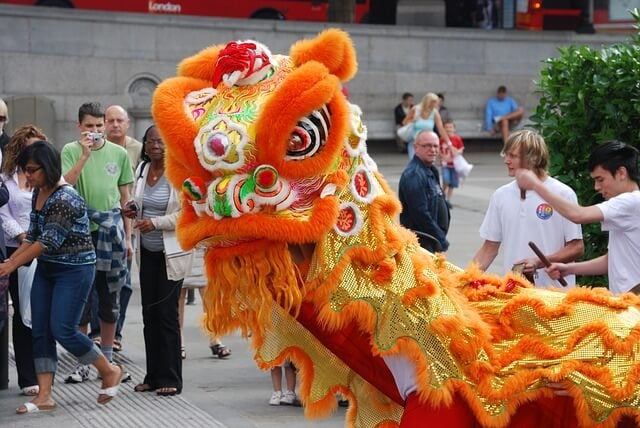
Chinese emperors from most Chinese dynasties and kingdoms used dragons to represent their ultimate and divine power over the land while their empresses often bore phoenix symbolism. Naturally, the dragon made the perfect symbol for the emperor, as it was the most powerful mythical creature. Wearing the Dragon Robes (longpao) was a great honor, and only a select few were allowed this honor.
In the Yuan dynasty, for example, a distinction was made between dragons with five claws on their feet and ones with just four claws. Naturally, the emperor was represented by five-clawed dragons while the princes and other royal members bore the marks of four-clawed dragons.
Dragon symbolism wasn’t reserved just for the ruling dynasties, at least not entirely. While wearing dragon-adorned robes and jewelry was typically done by the country’s rulers, people commonly had dragons paintings, sculptures, amulets, and other such artifacts. The symbolism of the dragon was such that it was revered across the empire.
Dragons were also often a central part of Chinese state flags:
- An azure dragon was part of the first Chinese national flag during the Qing dynasty.
- A dragon was also a part of the Twelve Symbols national emblem
- There was a dragon in the colonial arms of Hong Kong
- The Republic of China had a dragon on its national flag between 1913 and 1928.
Today, the dragon isn’t a part of China’s state flag or emblems but it is still valued as an important cultural symbol.
Chinese Dragon Today
The dragon continues to be an important symbol of China, represented in festivals, media, pop culture, fashion, in tattoos and many other ways. It continues to be a highly recognizable symbol of China and represents the traits that many Chinese wish to emulate.








